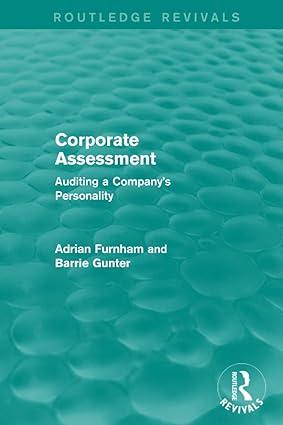Question
1. Which of the following pertains primarily to the planning of fixed overhead costs? a. A standard rate per output unit is developed. b. Only
1. Which of the following pertains primarily to the planning of fixed overhead costs? a. A standard rate per output unit is developed. b. Only essential activities are to be undertaken. c. Activities are to be undertaken in the most efficient method. d. Key decisions are made at the start of the budget period determining the level of costs. 2. In selecting a cost-allocation base for variable overhead, what criteria for the base is preferred? a. Ease of acquiring reliable information for accurate allocations b. A cause-and-effect relationship between the cost and the activity level c. A single base that will simplify the allocation process d. One that has been used in the past The following data apply to questions 3 through 10. Sebastian Company, which manufactures electrical switches, uses a standard cost system and carries all inventories at standard. The standard manufacturing overhead costs per switch are based on direct labor hours and are shown below: Variable overhead (5 hours @ $12 per direct manufacturing labor hour) $ 60 Fixed overhead (5 hours @ $15* per direct manufacturing labor hour) 75 Total overhead per switch $135 *Based on capacity of 200,000 direct manufacturing labor hours per month. The following information is available for the month of December: 46,000 switches were produced although 40,000 switches were scheduled to be produced. 225,000 direct manufacturing labor hours were worked at a total cost of $5,625,000. Variable manufacturing overhead costs were $2,750,000. Fixed manufacturing overhead costs were $3,050,000. 3. The variable overhead spending variance for December was a. $50,000 U. b. $350,000 U. c. $10,000 F. d. $60,000 F. 4. The variable manufacturing overhead efficiency variance for December was a. $50,000 U. b. $350,000 U. c. $10,000 F. d. $60,000 F. 5. The total variable manufacturing overhead variance was a. $10,000 F. b. $10,000 U. c. $110,000 U. d. $110,000 F.
6. The fixed manufacturing overhead spending variance for December was a. $450,000 F. b. $400,000 F. c. $50,000 U. d. $775,000 F. 7. The fixed overhead production-volume variance for December was a. $450,000 F. b. $400,000 F. c. $50,000 U. d. $775,000 F. 8. What amount should be credited to the Allocated Manufacturing Overhead Control account for the month of December? a. $6,210,000 b. $5,800,000 c. $5,760,000 d. $5,700,000 9. The manufacturing overhead flexible-budget variance for December was a. $10,000 F. b. $40,000 U. c. $50,000 U. d. $100,000 U. 10. The manufacturing overhead spending variance for December was a. $10,000 F. b. $40,000 U. c. $50,000 U. d. $100,000 U. 11. Which of the following statements is true about overhead cost variance analysis using activity-based costing? a. Overhead cost variances are calculated only for output-unit level costs. b. Overhead cost variances are calculated only for variable manufacturing overhead costs. c. A comprehensive variance analysis can be conducted. d. Activity-based costing uses input measures for all activities, resulting in the inability to do flexible budgets needed for variance analysis. 12. Which of the following is an example of a nonmanufacturing cost that may be analyzed using variances? a. Factory rent b. Product distribution costs c. Indirect labor d. Factory supplies
Step by Step Solution
There are 3 Steps involved in it
Step: 1

Get Instant Access to Expert-Tailored Solutions
See step-by-step solutions with expert insights and AI powered tools for academic success
Step: 2

Step: 3

Ace Your Homework with AI
Get the answers you need in no time with our AI-driven, step-by-step assistance
Get Started


